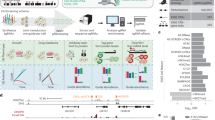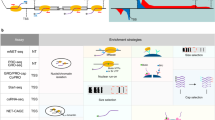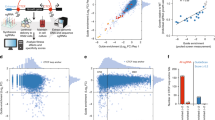Abstract
Systematic identification of noncoding regulatory elements has, to date, mainly relied on large-scale reporter assays that do not reproduce endogenous conditions. We present two distinct CRISPR-Cas9 genetic screens to identify and characterize functional enhancers in their native context. Our strategy is to target Cas9 to transcription factor binding sites in enhancer regions. We identified several functional enhancer elements and characterized the role of two of them in mediating p53 (TP53) and ERα (ESR1) gene regulation. Moreover, we show that a genomic CRISPR-Cas9 tiling screen can precisely map functional domains within enhancer elements. Our approach expands the utility of CRISPR-Cas9 to elucidate the functions of the noncoding genome
This is a preview of subscription content, access via your institution
Access options
Subscribe to this journal
Receive 12 print issues and online access
$209.00 per year
only $17.42 per issue
Buy this article
- Purchase on Springer Link
- Instant access to full article PDF
Prices may be subject to local taxes which are calculated during checkout




Similar content being viewed by others
References
Sexton, T. & Cavalli, G. The role of chromosome domains in shaping the functional genome. Cell 160, 1049–1059 (2015).
Mansour, M.R. et al. Oncogene regulation. An oncogenic super-enhancer formed through somatic mutation of a noncoding intergenic element. Science 346, 1373–1377 (2014).
Vahedi, G. et al. Super-enhancers delineate disease-associated regulatory nodes in T cells. Nature 520, 558–562 (2015).
Shi, J. & Vakoc, C.R. The mechanisms behind the therapeutic activity of BET bromodomain inhibition. Mol. Cell 54, 728–736 (2014).
Cho, S.W., Kim, S., Kim, J.M. & Kim, J.S. Targeted genome engineering in human cells with the Cas9 RNA-guided endonuclease. Nat. Biotechnol. 31, 230–232 (2013).
Shalem, O. et al. Genome-scale CRISPR-Cas9 knockout screening in human cells. Science 343, 84–87 (2014).
Wang, T., Wei, J.J., Sabatini, D.M. & Lander, E.S. Genetic screens in human cells using the CRISPR-Cas9 system. Science 343, 80–84 (2014).
Muller, P.A. & Vousden, K.H. p53 mutations in cancer. Nat. Cell Biol. 15, 2–8 (2013).
Schmitt, C.A. et al. A senescence program controlled by p53 and p16INK4a contributes to the outcome of cancer therapy. Cell 109, 335–346 (2002).
Beelen, K., Zwart, W. & Linn, S.C. Can predictive biomarkers in breast cancer guide adjuvant endocrine therapy? Nat. Rev. Clin. Oncol. 9, 529–541 (2012).
Melo, C.A. et al. eRNAs are required for p53-dependent enhancer activity and gene transcription. Mol. Cell 49, 524–535 (2013).
Li, W. et al. Functional roles of enhancer RNAs for oestrogen-dependent transcriptional activation. Nature 498, 516–520 (2013).
Sanjana, N.E., Shalem, O. & Zhang, F. Improved vectors and genome-wide libraries for CRISPR screening. Nat. Methods 11, 783–784 (2014).
Drost, J. et al. BRD7 is a candidate tumour suppressor gene required for p53 function. Nat. Cell Biol. 12, 380–389 (2010).
Voorhoeve, P.M. et al. A genetic screen implicates miRNA-372 and miRNA-373 as oncogenes in testicular germ cell tumors. Cell 124, 1169–1181 (2006).
el-Deiry, W.S. et al. WAF1, a potential mediator of p53 tumor suppression. Cell 75, 817–825 (1993).
Kim, T.K. et al. Widespread transcription at neuronal activity-regulated enhancers. Nature 465, 182–187 (2010).
Léveillé, N. et al. Genome-wide profiling of p53-regulated enhancer RNAs uncovers a subset of enhancers controlled by a lncRNA. Nat. Commun. 6, 6520 (2015).
Mali, P. et al. RNA-guided human genome engineering via Cas9. Science 339, 823–826 (2013).
Fullwood, M.J. et al. An oestrogen-receptor-alpha-bound human chromatin interactome. Nature 462, 58–64 (2009).
Arnold, A. & Papanikolaou, A. Cyclin D1 in breast cancer pathogenesis. J. Clin. Oncol. 23, 4215–4224 (2005).
Messeguer, X. et al. PROMO: detection of known transcription regulatory elements using species-tailored searches. Bioinformatics 18, 333–334 (2002).
Sigoillot, F.D. & King, R.W. Vigilance and validation: Keys to success in RNAi screening. ACS Chem. Biol. 6, 47–60 (2011).
Kearns, N.A. et al. Functional annotation of native enhancers with a Cas9-histone demethylase fusion. Nat. Methods 12, 401–403 (2015).
Kleinstiver, B.P. et al. Engineered CRISPR-Cas9 nucleases with altered PAM specificities. Nature 523, 481–485 (2015).
Canver, M.C. et al. BCL11A enhancer dissection by Cas9-mediated in situ saturating mutagenesis. Nature 527, 192–197 (2015).
Botcheva, K., McCorkle, S.R., McCombie, W.R., Dunn, J.J. & Anderson, C.W. Distinct p53 genomic binding patterns in normal and cancer-derived human cells. Cell Cycle 10, 4237–4249 (2011).
Rashi-Elkeles, S. et al. Parallel profiling of the transcriptome, cistrome, and epigenome in the cellular response to ionizing radiation. Sci. Signal. 7, rs3 (2014).
Smeenk, L. et al. Characterization of genome-wide p53-binding sites upon stress response. Nucleic Acids Res. 36, 3639–3654 (2008).
Yang, X. et al. A public genome-scale lentiviral expression library of human ORFs. Nat. Methods 8, 659–661 (2011).
Agami, R. & Bernards, R. Distinct initiation and maintenance mechanisms cooperate to induce G1 cell cycle arrest in response to DNA damage. Cell 102, 55–66 (2000).
Langmead, B. & Salzberg, S.L. Fast gapped-read alignment with Bowtie 2. Nat. Methods 9, 357–359 (2012).
Kim, D. et al. TopHat2: accurate alignment of transcriptomes in the presence of insertions, deletions and gene fusions. Genome Biol. 14, R36 (2013).
Anders, S., Pyl, P.T. & Huber, W. HTseq--a Python framework to work with high-throughput sequencing data. Bioinformatics 31, 166–169 (2015).
Cunningham, F. et al. Ensembl 2015. Nucleic Acids Res. 43, D662–D669 (2015).
Zhang, Y. et al. Model-based analysis of ChIP-seq (MACS). Genome Biol. 9, R137 (2008).
Kumar, V. et al. Uniform, optimal signal processing of mapped deep-sequencing data. Nat. Biotechnol. 31, 615–622 (2013).
Ross-Innes, C.S. et al. Differential oestrogen receptor binding is associated with clinical outcome in breast cancer. Nature 481, 389–393. (2012).
Acknowledgements
We would like to acknowledge K. Rooijers for help in bioinformatic analyses, insightful ideas and critical discussions. We thank W. de Laat, P. Krijger, B. Evers, M. Amendola and R. Maia for reagents and technical assistance. We also thank all members of the Agami group for helpful discussions. And we thank F. Zhang (MIT) for the gift of plasmid vector lentiCRISPRv2 and D. Root (MIT) for pLX304-GFP. R.L. is a fellow of the Fundação para a Ciência e Tecnologia de Portugal (SFRH/BD/74476/2010; POPH/FSE). This work was supported by funds of The Human Frontier Science Program (LT000640/2013) to A.P.U., and enhReg ERC-AdV and NWO (NGI 93512001/2012) to R.A.
Author information
Authors and Affiliations
Contributions
G.K., R.L. and R.A. conceived the project. G.K. and R.L. performed most of the experiments. A.P.U. did all luciferase assays. W.Z. and E.N. carried out and analyzed the ChIP-Seq data, respectively. R.H. helped during the library preparation. K.M. did cloning and validation of candidates from the screens. R.E. conducted all the bioinformatics analyses. G.K., R.L. and R.A. wrote the manuscript.
Corresponding authors
Ethics declarations
Competing interests
The authors declare no competing financial interests.
Integrated supplementary information
Supplementary Figure 1 Light microscopy images of cell populations transduced with the indicated sgRNA vectors.
(a, b and c) Images were taken after 15 days of HRASG12V induction.
Supplementary Figure 2 p53enh3508 region exhibits a p53-dependent enhancer activity that is required for OIS activation.
(a) Senescence induction was quantified using senescence-associated β-gal assay. (b) MCF-7 cells were transfected with the indicated vectors, treated with Nutlin-3a 5-10 hours later, and harvested 25-30hr after treatment. The relative luciferase activities (Firefly/Renilla) were normalized to the Ctrl reaction. (All p-values for luciferase assay were calculated by Student’s t-test. * indicates the significance relative to empty vector; # indicates the significance relative to untreated matching sample). (c) The same assay as in panel b, only that cells were co-transfected with control, or p53-targeting siRNAs. A reporter vector containing the enhancer region p53-BER420 was used as a positive control for p53-dependency. The efficiency of p53 knockdown was determined by immunoblot analysis. (All p-values for luciferase assay were calculated by Student’s t-test. * indicates the significance relative to empty vector).
Supplementary Figure 3 deCDKN1A contains key enhancer elements that regulate OIS in a p53-dependet fashion.
(a) The same cell extracts as in Figure 2g were blotted with an antibody against HRAS. (b) qRT-PCR analysis of CDKN1A mRNA levels performed with the indicated BJ-indRASG12V cell populations following induction of RASG12V. (n=3; *P<0.05, two-tailed Student’s t-test). (c) MCF-7 cells were transfected with the indicated reporter vectors, treated with Nutlin-3a 5-10 hours later, and harvested 25-30 hours later. The relative luciferase activities (Firefly/Renilla) were normalized to the Ctrl reaction. (d and e) The same cell populations as in b panel were subjected to BrdU labeling and β-gal assays to assess proliferation and OIS, respectively. N=2; for each condition at least 150 cells were count. *P<0.05, two-tailed Student’s t-test. (f) Western blot analysis of BJ-indRASG12V CDKN1A KO and control cells. P53 and HSP90 were used as controls.
Supplementary Figure 4 ERαenh588 regulates CCND1 activity in an estrogen-dependent manner.
(a) Screenshot of ChIA-PET analysis in MCF-7 cells showing a strong chromatin interaction between enh588 and CCND1 promoter. (b) MCF-7 cells were seeded with charcoal-treated medium and transfected with the indicated reporter vectors. 16 hours later the medium was refreshed and either supplemented or not with 17β-estradiol. 24 hours later cells were harvested and luciferase activity was measured. The relative luciferase activities (Firefly/Renilla) were normalized to the Ctrl reaction. (c) Complete blot shown in Figure 3h.
Supplementary Figure 5 Results of PROMO analyses are shown for regions surrounding the p53 BS and Hit38.
The p53 BS and the sgRNA-Hit38 targeting region are indicated, and the sequences representing potential CEBPB binding are underlined.
Supplementary information
Supplementary Text and Figures
Supplementary Figures 1–5 and Supplementary Tables 1–7 (PDF 3764 kb)
Rights and permissions
About this article
Cite this article
Korkmaz, G., Lopes, R., Ugalde, A. et al. Functional genetic screens for enhancer elements in the human genome using CRISPR-Cas9. Nat Biotechnol 34, 192–198 (2016). https://doi.org/10.1038/nbt.3450
Received:
Accepted:
Published:
Issue Date:
DOI: https://doi.org/10.1038/nbt.3450
This article is cited by
-
Multicenter integrated analysis of noncoding CRISPRi screens
Nature Methods (2024)
-
Cis-regulatory atlas of primary human CD4+ T cells
BMC Genomics (2023)
-
Landscape of enhancer disruption and functional screen in melanoma cells
Genome Biology (2023)
-
Identification of non-coding silencer elements and their regulation of gene expression
Nature Reviews Molecular Cell Biology (2023)
-
Cancer lineage-specific regulation of YAP responsive elements revealed through large-scale functional epigenomic screens
Nature Communications (2023)



